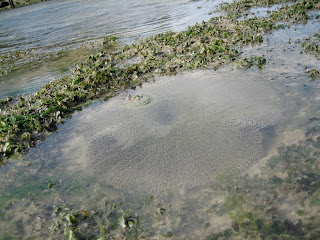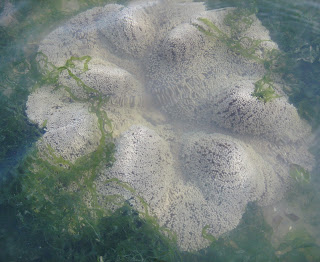:: Yes, it does seem about the right time that I had a blog. A blog specifically to write about my jaunts with Team Seagrass, Naked Hermit Crabs and Koh Sheng's CJ project on Chek Jawa to various shores and nature spots on Singapore . And the wonderful, amazing and sometimes peculiar things(and people) that I encounter during these trips. ::
:: Was back on Chek Jawa on Tuesday after Sunday's Team Sea Grass monitoring (which left me with an ugly tan line which gave the impression that I was wearing a big sports bra) to volunteer for Kok Sheng's CJ project. What we volunteers do is monitor key species on Chek Jawa (which suffered losses in a mass death last January due to the monsoon) and collecting data for Kok Sheng. Anyway, its just another excuse for to visit Chek Jawa and play in the sun while the rest of the world are stuck behind their desks. * grin* ::


:: Herons, egrets and other shore birds can be seen feeding on the intertidals while at House No. 1. The sky was a shocking blue, and as the tide receded out, pools of water amongst sand bars and rocks filled with the glint and glitter of sea life. ::


:: The Chek Jawa Boardwalk. The public can sign up for guided walks with NParks on this almost lost shore. Here, July puts up " Research in Progress" sign. ::


:: Intrepid volunteers from Team Anemone braving the mid-day heat. Kok Sheng was the star of the day, where the team from Channel 8 came to film a programme on volunteers who work to save the environment. And in Mandarin! (what do you call a sea star in Mandarin? Hai Xing?) ::
:: This tiny crab is called an Elbow Crab, Why? Look at its pincers... ::


:: Sea Hares are in season at Chek Jawa. Have always wanted to see them and I was in luck. There were everywhere. Sea Hares are molluscs and have an internal shell. They are also hermaphrodites. How lucky eh? Above, right, the sea hare is seeking shade from the sun by attempting to burrow under the dead flower crab. ::

:: We saw this brittle star on the sand bank. One of the many STARS of Chek Jawa. ::


:: Found this empty mass of egg sacs. Well Ria and I were arguing whether if it was an empty one. I thought it probably looked liked squid eggs. But subsequently Ron told me that (below) were unhatched octopus eggs so probably all the babies have hatched and swam away. Anyway, I thought the egg mass look rather like a black sea cucumber. ::
:: The carpet anemones (Stichodactyla haddoni)were doing well. In fact, we saw many of them...some really big. ::
:: Was told that these carpet anemones can grow to 1m in length. Told Ria imagine if we just left them alone, to their own devices, evolution might allow them to grow to an immense size...and well, who knows, maybe one day we might hear of killer carpet anemone devouring unsuspecting Chek Jawa volunteers. *snort* ::


:: One of my favourites denizens at Chek Jawa. The peacock anemones, in various shades of shocking orange, green and pink, usually comes out of their tubes when its cooler in the day, waving their dainty tentacles through the water to snare unsuspecting prey. ::
:: View of the House 1 below the boardwalk. Large meadows of sea grasses could be found here. Maybe a transect here next time? ::


:: Besides the usual barnacles, drills, whelks and sponges found on the pillars of the boardwalk, we found a few bunches of pink soft corals. Ria pointed out a certain species of cowrie/snail which looks exactly like the warts and bumps of the soft coral lived amongst its fronds, but alas, even though we molested a few, we didn't find any. ::


:: Chanced upon this meter long monitor lizard scampering away into the cliffs as I approached. They are fairly common on Ubin and are mostly scavengers. ::
:: Mussels. Found in clumps usually under the boardwalk and pontoon. ::
:: These are sand dollars, the currencies of the shore. If only! I'll be rich! Related to sea stars, sea cucumbers and sea urchins (Echinoderms), sand dollars are found on the sand bar, leaving their trails, leading unassuming lives, eating detritus..until someone accidentally steps onto one of them. Sounds like some people I know.. ::

:: As the day got cooler, the sea cucumbers start popping out from their burrows. From Left: the sandfish sea cucumber (holothuria scabra) also affectionately known as the garlic bread sea cucumber (thanks Ria), the ball sea cucumber (Phyllophorus sp.) also known by the Malays as gamut, and the slimy smooth sea cucumber that reminds me of something sexy that I really shouldn't say on this blog. ::

:: Tube worms by the thousands resides on the sand bar. When the tide comes in, the worms come out, displaying their feathery tentacles to feed... ::



:: As the day got cooler, the sea cucumbers start popping out from their burrows. From Left: the sandfish sea cucumber (holothuria scabra) also affectionately known as the garlic bread sea cucumber (thanks Ria), the ball sea cucumber (Phyllophorus sp.) also known by the Malays as gamut, and the slimy smooth sea cucumber that reminds me of something sexy that I really shouldn't say on this blog. ::

:: Tube worms by the thousands resides on the sand bar. When the tide comes in, the worms come out, displaying their feathery tentacles to feed... ::


:: Ria found a nudibranch (Armina barbai) and since I am rather new to this Latin identification for creatures, I remember its name by calling it Armina's Babi. Anyway, I have been told that it exudes a strong medicinal smell when molested/threatened. And below, I found this nudibranch Dendrodoris denisoni near the pontoon...argh, my clumsy tongue can't keep up! ::


:: Found these sea hares doing the nasty while two sand stars scurried away...the orangy mess of threads are the result of the sea hares amorous activities. ::


:: Found these sea hares doing the nasty while two sand stars scurried away...the orangy mess of threads are the result of the sea hares amorous activities. ::
:: Thus was a lovely day thanks to Kok Sheng and Ria and everyone else. And this blog post is really hard to do. Urgh! I actually have a video of a train of sea hares in an orgy but its taking too long to upload so...maybe later when I get a hang of this whole blogging thing. ::















3 comments:
Welcome to the world of blogging! Haha... Now you join the gang of ppl who speaks latin that most others won't understand, rentlessly snaps and loads photos, type tons and religiously post after every single trip!
Nice first entry btw. Cheers!
Pai seh, that shld be cuttlefish eggs, not octopus eggs. I blur that day, see wrongly. For octopus eggs, the outer tip of each capsule should be rounded, but this one is cleary pointed, so should be cuttlefish eggs :P
a wonderful blog you have there. very informative as well. keep up the good work!
shall look forward to more of your posts on nature from now on
Post a Comment